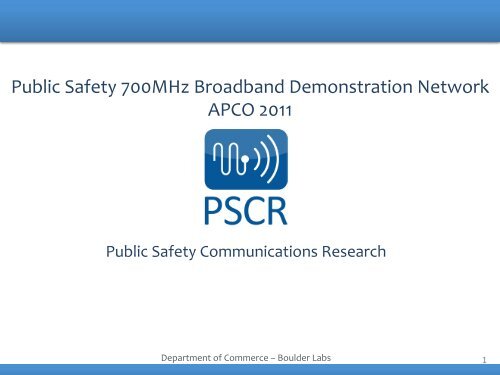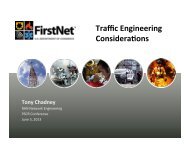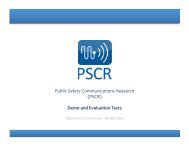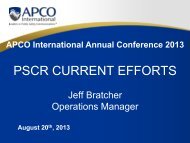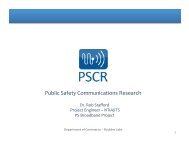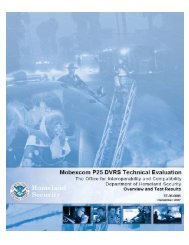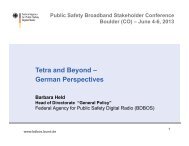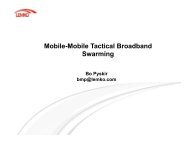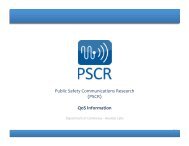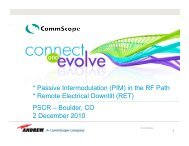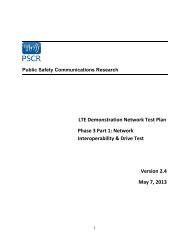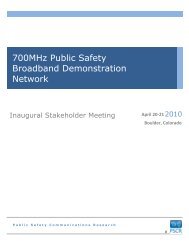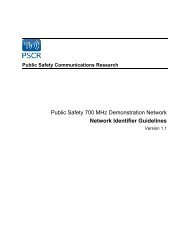Demonstration Network Review - PSCR
Demonstration Network Review - PSCR
Demonstration Network Review - PSCR
Create successful ePaper yourself
Turn your PDF publications into a flip-book with our unique Google optimized e-Paper software.
Public Safety 700MHz Broadband <strong>Demonstration</strong> <strong>Network</strong> <br />
APCO 2011 <br />
Public Safety Communications Research <br />
Department of Commerce – Boulder Labs <br />
1
Agenda <br />
• <strong>PSCR</strong> Introductions & Overview <br />
• Testing Updates <br />
• CRADA Updates <br />
• Study Item updates <br />
• Next meeting <br />
2
Genesis of <strong>PSCR</strong> Demo <strong>Network</strong> <br />
• Spring 2010 <strong>PSCR</strong> kicks off 700 MHz LTE <br />
<strong>Demonstration</strong> <strong>Network</strong> <br />
– The only government or independent lab facility located <br />
in the United States to test and demonstrate public <br />
safety 700 MHz broadband networks and applications, <br />
the <strong>Demonstration</strong> <strong>Network</strong> provides: <br />
• A vendor-‐neutral place for manufacturers and carriers to deploy their <br />
systems to test them in a multi-‐vendor environment. This provides <br />
integration opportunities. <br />
• A place for public safety to see how these systems will function, specific to <br />
their unique needs. Interested agencies can visit the network and get <br />
hands-‐on experience with these systems, as well as run public safety <br />
specific test cases that relate directly to their operational environments. <br />
• A place where early builders can ensure that the systems they might <br />
procure will in fact work in the eventual nationwide network, assisting <br />
agencies in their procurement process. <br />
3
<strong>Demonstration</strong> <strong>Network</strong> Overview <br />
• R&D nationwide interoperability through a unified <br />
approach to network design and implementation <br />
– Testing (conformance, performance and evaluation) <br />
– Multi-‐site/vendor Over-‐The-‐Air network – allows <br />
consistent testing between vendors <br />
• All eNodeBs co-‐located and share common antenna system <br />
• EPCs local and remote <br />
• Dedicated RF & Interoperability test labs <br />
– Develop guidelines/Industry Requirements for network <br />
architecture, RF, IP, PLMN, IMSI, eNUM, Security, <br />
Application…etc <br />
– Advanced feature testing – QCI, ARP, eMBMS, FFR, <br />
Channel Bonding, IPX/Roaming <br />
4
<strong>PSCR</strong> Demo <strong>Network</strong> Project Plan <br />
• Generate interest from broadband vendors to develop <br />
a 700 MHz broadband equipment ecosystem <br />
– Band Class 14 (D Block & Public Safety Block), Long Term Evolution <br />
(LTE) <br />
– Stimulate early development for public safety systems (e.g. Waiver <br />
Orders) <br />
– Support the commercial standards and testing process with public <br />
safety requirements e.g. <br />
– Publish test results (non-‐attributable) to inform stakeholders <br />
5
Demo Project Stakeholders <br />
NOTE: This is a partial stakeholder list<br />
6
Project & Testing <br />
Updates <br />
7
Project Process <br />
• <strong>Demonstration</strong> <strong>Network</strong> has three major <br />
stages for stakeholder participation: <br />
1. Stage 1—<strong>Network</strong> and Test Planning <br />
• Stakeholders will be involved in creating a common test plan for <br />
all vendors and creating a common network deployment and <br />
coverage scheme. <br />
2. Stage 2—Deployment (3 sub-‐phases) <br />
1. Equipment is scheduled for delivery to site locations. <br />
2. Coverage, network planning, site preparation is completed. <br />
3. Systems are installed and commissioned. <br />
3. Stage 3—Testing and <strong>Demonstration</strong>s <br />
• Test plan execution takes place. This is staggered into three <br />
main phases with sub-‐phases as equipment and features <br />
become available. <strong>Network</strong> is available to perform system level <br />
testing and demonstrations on. <br />
8
Project Status – Stage 1 <br />
• Stage 1 is nearing completion <br />
– Phase 1 and 2.1 stable and released <br />
– Test planning for Phase 2.2 and Phase 3 out for <br />
review <br />
• Phase 2.2 target publish date by end of August 2011 <br />
• Phase 3 target publish date by end of September 2011 <br />
– UE related tests removed from Phase 1 test plan <br />
• UE test plan standalone from system & infrastructure <br />
testing <br />
– All test documents available on www.pscr.gov <br />
9
Project Status – Stage 2 <br />
• Infrastructure deployment <br />
– Alcatel Lucent EPC & eNodeB completed <br />
– Motorola Solutions Inc./Ericsson EPC & eNodeB <br />
• Phase 1 test configuration complete <br />
• Phase 2 & 3 test configuration in progress (late Q3) <br />
– Harris/Nokia Siemens EPC & eNodeB <br />
• Phase 1 test configuration complete <br />
• Phase 2 & 3 test configuration in progress (Sept) <br />
– Cisco EPC installation beginning in two weeks, <br />
integration in early September <br />
– IPWireless TBD <br />
10
Project Status – Stage 2 cont. <br />
• UE & UICC deployment <br />
– LG deployed <br />
– Motorola Solutions Inc. deployed <br />
– IPWireless deployed <br />
– Gemalto deployed <br />
– Others TBD <br />
• Test Equipment <br />
– Aeroflex, Agilent, Rohde & Schwarz, Anritsu, <br />
Sanjole <br />
11
Stage 3 -‐ Testing Updates (1) <br />
• The <strong>PSCR</strong> program has established a test plan with <br />
three major phases of testing and evaluation. <br />
– Phase 1: Basic Functionality Testing <br />
• Phase 1: Basic Functionality Tests <br />
• Basic functionality testing will determine if the LTE equipment <br />
submitted for use in the <strong>PSCR</strong> demonstration project has been <br />
configured correctly to achieve a minimal level of functionality. <br />
Tests will include: <br />
– Physical layer tests to ensure that the submitted equipment <br />
will not interfere with other existing 700 MHz LMR, <strong>PSCR</strong> <br />
demonstration systems <br />
– Messaging/protocol tests <br />
– Public safety application tests <br />
– Basic performance tests <br />
12
Stage 3 -‐ Testing Updates (2) <br />
• Phase 2.1: System and Node Level Testing <br />
– Predominately simulated propagation <br />
• Physical Layer Tests: Examine several characteristics <br />
of the eNB that will indicate how this equipment will <br />
operate in PS scenarios. <br />
– Provides indication of sensitivity level and robustness for <br />
the RF section of the eNB. <br />
• Throughput Performance Tests <br />
– Tests examine throughput in bidirectional, downlink and <br />
uplink configurations. <br />
– Test configurations examine both TCP and UDP throughput. <br />
• Messaging/Protocol Tests: The test in this phase <br />
examines the messaging behavior of the LTE system <br />
in the event that an additional radio bearer is <br />
requested. <br />
13
Stage 3 -‐ Testing Updates (3) <br />
• Phase 2.2: System and Node Level Testing <br />
– Stress Tests: These tests will examine the loading and <br />
potential capacity of the target cell. <br />
• Multi-‐user, loaded network stress testing <br />
– Performance Tests: There are three tests, two of which <br />
are designed to examine user plane latency. <br />
– Messaging/Protocol Tests: These tests cover the areas <br />
of security, interoperability, and failure modes. <br />
• The Security tests focus on intrinsic security modes in LTE as <br />
opposed to Over the Top (OTT) methods that may be used at <br />
higher levels in the protocol stack. <br />
– <strong>Network</strong> O&M -‐ Alarm/Fault Reporting <br />
– “Status Info Homepage” evaluate a standardized <br />
mechanism to quickly inform the user of system <br />
information. <br />
14
Stage 3 -‐ Testing Updates (4) <br />
• Phase 3: Advanced Feature, Conformance, Interoperability, <br />
and Roaming Testing <br />
– <strong>Network</strong> architecture type testing, including evaluation of various <br />
PLMN, eNUM and IP implementations <br />
– Interoperability testing that includes testing the EPC and inter-connecting<br />
multiple EPCs <br />
• Basic RAN IOT – UE and eNB based both <br />
– Handover testing and evaluation (pending UE availability) <br />
• LTE-‐to-‐LTE (public safety-‐to-‐public safety) <br />
• LTE-‐to-‐LTE (PS to commercial) <br />
• LTE-‐to-‐3G <br />
– Stress, performance, messaging/protocol, application tests all <br />
included. Several based off of VZW Open Test Procedures <br />
• New webpage created just for testing updates: <br />
http://www.pscr.gov/projects/broadband/700mhz_demo_net/testing/about_testing.php <br />
15
Testing Status <br />
• Phase 1 tests published & available on <br />
www.pscr.gov <br />
– Test plan stable at v1.12 <br />
– Completed Phase 1 testing with Alcatel-‐Lucent <br />
– Started testing with MSI and NSN <br />
• Phase 2.1 testing complete with Alcatel-‐Lucent (in <br />
review now) <br />
• Phase 2.2 scheduled to start late August (ALU) <br />
• Phase 3 TBD start date <br />
• Once we have multiple vendors that have executed <br />
all tests we will publish data (non-‐attributable) <br />
16
UE Testing <br />
• UE testing covers several key aspects <br />
– RF Conformance & Performance tests based on several <br />
key documents <br />
• 3GPP 36.521-‐1 v8.4.0 (Dec 2009) <br />
• PTCRB RFT #76 <br />
– Radio Resource Management (RRM) Conformance <br />
Testing <br />
• 3GPP 36.521-‐3 v8.4.0 (Dec 2009) <br />
– Scenario Based Tests <br />
• Based upon Verizon Wireless Device Requirements LTE 3GPP <br />
Band 13 <strong>Network</strong> Access Issued May 2010 v4.0 <br />
– Field Performance Tests <br />
• Verizon Wireless Device Requirements LTE 3GPP Band 13 <br />
• GSMA DG.11 Device Field and Lab Test Guidelines, Version 8.0, 11 <br />
June 2010, Annex C <br />
17
UE Testing (2) <br />
• Using Conformance test equipment – R&S 8980S <br />
w/Contest 2.20 <br />
• <strong>PSCR</strong> looking to move most UE testing to PTCRB <br />
certified labs <br />
• Working with PTCRB on PVG submittal for Band 14 <br />
validation <br />
– CRADAs signed with 7Layers & AT4 Wireless + 1 in <br />
progress <br />
– One lab has already tested on one UE chipset but did not <br />
meet 2 chipset criteria <br />
• No UE vendors have final designs ready for full <br />
conformance yet <br />
– Could have testing done by end of 2011 if UEs <br />
18
Infrastructure Conformance <br />
• <strong>PSCR</strong> submitted a new work item in March 2011 to <br />
the Multi-‐Service Forum entitled: MSF LTE EPC <br />
Certification Program <br />
– Initially accepted but slow response for sponsorship due <br />
to “certification” aspect <br />
– Initially tested S1-‐MME <br />
• Would eventually evaluate : <br />
– S1-‐U (eNB to S-‐GW) <br />
– S-‐11 (MME to S-‐GW) <br />
– S6a (MME to HSS) <br />
– S5 (S-‐GW to P-‐GW) <br />
– Gx (P-‐GW to PCRF) <br />
– Rx (PCRF to P-‐CSCF) <br />
19
Infrastructure Conformance (2) <br />
• <strong>PSCR</strong> will re-‐submit a modified work item next <br />
week at the August 2011 MSF that removes <br />
certification aspect <br />
• <strong>PSCR</strong> still investigating other organizations such as <br />
GSMA and ATIS to perform infrastructure IOT for <br />
public safety on an on-‐going basis <br />
20
Study Item Groups <br />
Updates <br />
21
Study Item Groups <br />
• <strong>PSCR</strong> has defined nine initial, specific Study Items for the <br />
Broadband <strong>Demonstration</strong> <strong>Network</strong>. These Study Items are <br />
areas of technical need identified within the <strong>PSCR</strong> <br />
<strong>Demonstration</strong> <strong>Network</strong> project that require input from our <br />
stakeholders. <br />
• <strong>PSCR</strong> will directly be leading six of these groups. <br />
• The other three Study Items will be handled outside of <br />
<strong>PSCR</strong> e.g. NPSTC – we are working with these organizations <br />
to ensure a smooth transition and will provide updates on <br />
how to specifically get involved in these three other Study <br />
Items. <br />
• To join the groups goto www.pscr.gov and sign up for the <br />
groups and for sharepoint/web portal access <br />
22
Study Item Groups (2) <br />
• The following Study Items will be led by the <strong>PSCR</strong> <br />
Project Team: <br />
– UE Testing <br />
– <strong>Network</strong> Identifiers <br />
– <strong>Network</strong> Performance <br />
– Infrastructure Testing -‐ RAN & EPC <br />
– Roaming & Clearing <br />
– UICC <br />
• The remaining Study Items will eventually be <br />
folded back in to the <strong>PSCR</strong> Study Items <br />
– <strong>Network</strong> Security <br />
– QoS <br />
– Application Testing <br />
• Each Study Item has a scope of work document associated with it. <br />
23
CRADA <br />
Updates <br />
24
CRADA <br />
• CRADA – Cooperative Research And Development <br />
Agreement <br />
– CRADAs are partnering tools allowing federal <br />
laboratories to work with US industries, academia and <br />
other organizations on cooperative R&D projects. <br />
CRADAs provide flexibility in structuring project <br />
contributions, intellectual property rights, and in <br />
protecting proprietary information and CRADA research <br />
results. <br />
– 33 of 45 submissions executed <br />
• Project Phased Approach relates to phased CRADA execution <br />
• Judgment of NIST on whether or not to execute CRADA based <br />
on project needs <br />
25
Executed CRADAs <br />
26
Executed CRADAs <br />
• Alcatel Lucent <br />
• Andrew Commscope <br />
• Anritsu <br />
• IP Wireless <br />
• ISCO <br />
• LG <br />
• US Cellular <br />
• Wavesat <br />
• Cisco <br />
• Ixia <br />
• Ericsson <br />
• Aeroflex <br />
• T-‐Mobile <br />
• Agilent <br />
• Harris <br />
• EDX <br />
• Syniverse <br />
• Powerwave <br />
• Talley <br />
• In Motion Tech <br />
• Northrop Grumman Systems Corporation <br />
• Cassidian <br />
• Nokia Siemens <strong>Network</strong>s <br />
• Motorola Solutions Inc. <br />
• Rohde & Schwarz <br />
• Verizon Wireless (VZW) Cellco <br />
• Sprint Nextel <br />
• AT&T Services <br />
• 7 Layers Inc. <br />
• AIRCOM <br />
• JDS Uniphase Corp <br />
• AT4 Wireless <br />
• Twisted Pair Solutions <br />
27
CRADA Submissions <br />
• If you want to submit your information to <br />
execute a CRADA please provide the <br />
following to 700MHz@its.bldrdoc.gov <br />
1. Official Company name and address <br />
2. Company point of contact name, address, phone, email (this is the <br />
person that will sign the CRADA) <br />
3. Company Principal Investigator name, address, phone, email (this is <br />
our primary POC for the project) <br />
4. Names of other members of the Company's project team (active <br />
members of the project) <br />
5. What the company will be contributing to the research-‐-‐ such as <br />
specific infrastructure equipment, subscriber equipment, test <br />
equipment, antenna's, software testing, hardware testing or any other <br />
collaboration. <br />
28
Face-‐to-‐Face <br />
• Semi-‐Annual <strong>PSCR</strong> Face-‐to-‐Face meetings <br />
held in April 2010 & December 2010 <br />
• Tentatively scheduling for late July or early <br />
November 2011 in Boulder, CO -‐ but remains <br />
TBD based on testing <br />
• Considering hosting virtual web conference <br />
– Send email to 700MHz@its.bldrdoc.gov to get <br />
added to distribution list or if interested in <br />
presenting <br />
– Will update via email distribution list and <br />
www.pscr.gov website <br />
29
Emil Olbrich<br />
<br />
For Addi2onal Informa2on: <br />
h;p://www.pscr.gov <br />
QUESTIONS<br />
emil.olbrich@nist.gov <br />
& RESOURCE <br />
30


